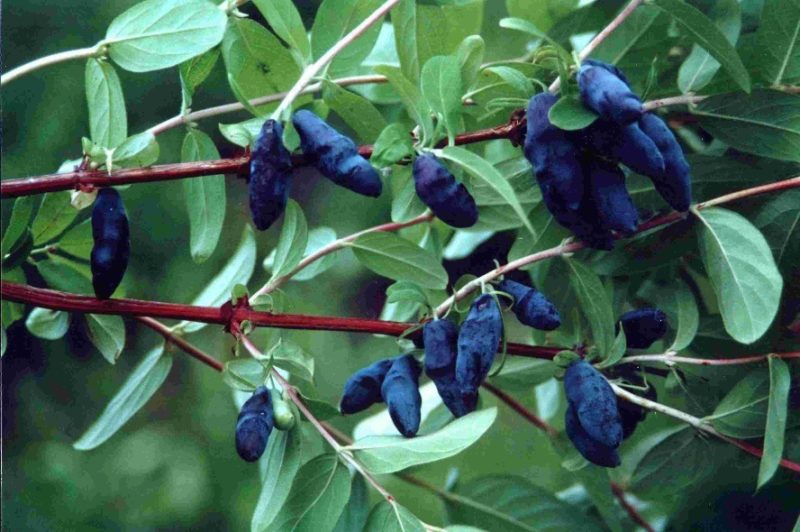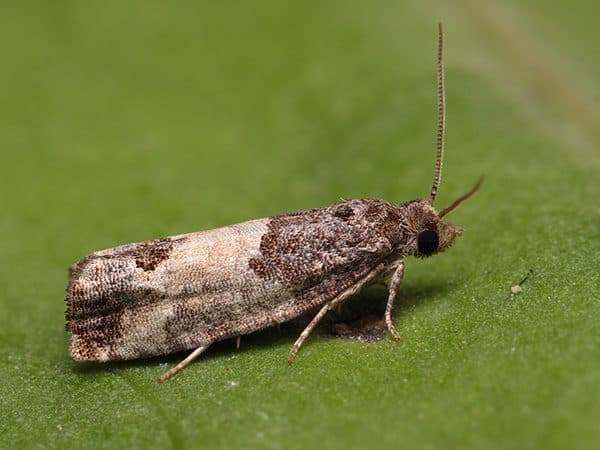Large-fruited delicious variety of honeysuckle Lazurnaya
Most representatives of the Honeysuckle family are ornamental plants. The scent of their flowers is a popular ingredient in women's perfumes. Tart and fresh notes of honeysuckle are used in the collections of Givenchy (Organza), Chanel (Allure), Estée Lauder (Modern Muse). But there are no less interesting varieties that can not only be grown in your garden, but also used for food. Honeysuckle Azure is a prominent representative of edible varieties.
Description of the honeysuckle variety Lazurnaya
Honeysuckle Azure is a mid-season, large-fruited, frost-resistant, partially self-pollinating variety, resistant to shedding, which makes it one of the most popular.
It was bred by breeders in the 60s. at NIISS in Barnaul as a result of pollination of Kamchatka honeysuckle.

Appearance
The variety is a medium-sized bush, the height of which can reach 1.7 m. Thin light green branches form a crown in the form of an inverted cone.
The leaves are large, oval-shaped, with slight hairiness and stipules. The berries are up to 2 cm in length, elongated, with a slight thickening in the middle and a pointed end.
The color of the fruit is blue-violet with a slight blue tinge. The berries are tender, sweet and sour in taste, without bitterness. The taste depends on the amount of moisture consumed by the plant during ripening.
Features of application
The berries of the Azure honeysuckle are edible; housewives make jams and jellies, homemade wines and compotes from them.
There are known ways to use berries in folk medicine.During flowering and fruiting, the shrub looks decorative.
Productivity and fruiting
Fruiting begins at 3-4 years of age and continues annually. On average, a plant produces berries for about 20 years. Ripening begins in the second half of June and continues throughout the month.
In the first years of life, the yield is less - one bush produces up to 1.5 kg of berries. Upon reaching 7 years, the figure increases to 2.3 kg per bush.
Important! Under favorable growth conditions, one bush produces 2.5 kg of berries.
Warm autumn promotes re-blooming. Then next year the bush will not bear fruit.
Resistance to diseases, pests, adverse conditions
Honeysuckle Azure has good immunity and is resistant to diseases and pests.
Under unfavorable weather conditions (excessive humidity), powdery mildew may appear on the bushes.
The shrub is characterized by frost resistance. It is dependent on moisture and requires regular watering at least once a week. It is important to avoid stagnation of moisture.
Tolerance to low temperatures contributes to the cultivation of the variety in the Urals and Siberia.
Read also:
Advantages and disadvantages
Advantages of the variety:
- large fruits;
- resistance of berries to shedding;
- frost resistance;
- immunity to diseases and pests.
Disadvantages of the variety:
- Fruiting occurs in 3-4 years;
- low yield up to 7 years.
Agricultural technology
Honeysuckle Azure prefers slightly acidic soil. The plant loves illuminated areas. In the shade, the fruits grow sour and small. Seedlings are not planted very deep in the spring.
A favorable place for planting is near a hedge. Soil drainage must be sufficient, because...Stagnant moisture will cause seedling disease.
Important! The shrub grows poorly on sandy and marshy soils.
It is important to select healthy seedlings no higher than 1.5 m, with good rhizomes without spots and growths. Planting dates are limited to April and early October.
The size of the hole is 0.4 × 0.4 × 0.4 m. The distance between them should be 2 m, between adjacent rows - 3 m. Fertilizers are added to the hole under each seedling: humus and horse humus - 10 kg, 100 g of double superphosphate, 30 g of potassium sulfate and 300 g of wood ash.
Proper care involves pruning branches that have dried out or are growing inside the bush. The first pruning is done before planting the plant. This promotes good branching. Annual pruning is carried out in the spring, before the buds open, or in early September, before the first frost. The length of the stumps is 30-40 cm.
Proper watering is important: 1-2 times a week, one bucket of water per bush in the morning or evening. Caring for seedlings includes loosening and mulching. For mulching, straw, sawdust, humus, and peat are placed between the rows. Laying height - 4 cm.
Honeysuckle Azure is a partially self-fertile shrub, so pollinators must be nearby for high yields. The varieties Gerda, Cinderella, Blue Bird, Blue Spindle, Long-fruited are suitable.
Reproduction
For propagation, a step-by-step method of green cuttings is used:
- From a faded bush, cut a cutting at the base so that there are 4 buds on the shoot.
- Soak the cuttings for 2 hours in a solution that stimulates root growth.
- Prepare the soil: mix peat with soil in a ratio of 1:3 and treat with an industrial fungicide.
- Plant the cuttings in containers with soil at a slope of 40°.
- Water and cover with glass.
- Ventilate and water the seedlings.The root system will form in 2 weeks.
- After the development of the root system, the seedlings are to be grown into a shkolka (temporary bed).
Preparing for winter
At the first frost, cover the seedlings with spruce branches and straw, and a year later transplant them into open ground.
Despite the fact that Lazurnaya honeysuckle is a winter-hardy variety, the bushes are covered for the winter, especially young seedlings. Horse humus is poured around the trunk of the plant. The root system of young bushes is sprinkled with straw and covered with spruce branches.
Disease and pest control
Proper planting and care of the plant significantly reduces the risk of disease. When air humidity is high, the bushes are affected by the fungal disease powdery mildew. This disease can be dealt with by spraying the bushes with Alirin and Fitosporin, soda solution or copper sulfate.
Dangerous from insect pests leaf roller, which contributes to the wrapping of leaves into a tube and the death of the plant. Treating bushes with Biotlin, Aktara, and Fufanon repels the pest and saves the seedlings.
Honeysuckle caterpillars are dangerous. The bush is sprayed with Chlorophos, Inta-Vir, and an infusion of potato and tomato tops.
Aphid drinks the juice of the plant, which leads to its death. In this case, traditional methods of control work well: spraying with a solution of soda, soap, ash or calendula solution. Chemical control agents include Biotlin, Confidor, and Inta-Vir.
Shchitovka sucks sap from the trunk of a bush. You can protect the plant by treating it with Admiral or Actellik.
Honeysuckle mite drinks the juice of the plant. The drugs Omite and Confidor are used against it.
Difficulties in growing
Honeysuckle Azure is an unpretentious variety, but moisture-loving. To maintain good growing conditions, the soil should not be allowed to dry out.
Harvesting
Fruiting lasts 3-4 weeks. Honeysuckle Azure is considered ripe when the berries turn blue and taste sweet.
Harvesting is done manually, the berries are placed in small containers, avoiding crushing. Some gardeners remove fruits by shaking them from the bush, after laying burlap or other fabric on the surface of the ground.
The collected fruits are stored and transported frozen; they remain in the refrigerator for up to 5 days.
Tips and reviews from experienced gardeners
Experienced gardeners recommend feeding Azure honeysuckle bushes with organic fertilizers once every few years. This feeding will ensure a good harvest.
They respond positively to the variety.
Vladimir, Primorsky Krai: “The most labor-intensive thing with this variety is picking the berries. My bushes are very tall, so the tops often remain unplucked, but at least they don’t fall off as soon as they ripen.”
Peter, Torzhok: “I’ve been growing honeysuckle for many years. One of the most beloved varieties in terms of taste is Lazurnaya (not to be confused with Radiant honeysuckle). The berries are sweet and large, with delicate pulp, great for desserts and freezing.”
Read also:
Conclusion
Honeysuckle Azure is an unpretentious frost-resistant plant that is resistant to diseases and pests. It does not require special care, thanks to which it grows successfully in cottages and garden plots.
The variety produces large and tasty fruits that do not fall off after ripening and are widely used in homemade preparations.